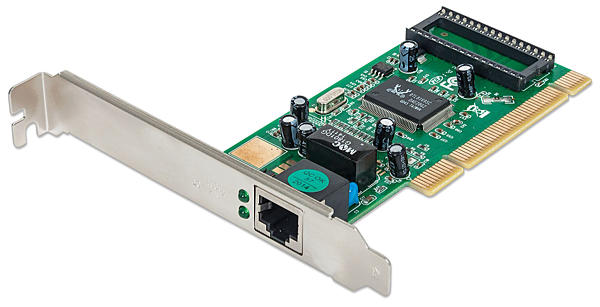What are Network Cards
A network card, also known as a network interface card (NIC), is a hardware component that is used to connect a computer or other device to a network. Network cards typically come in the form of an expansion card that can be inserted into an available slot on a desktop computer’s motherboard or a port built into a laptop or other device.
The primary function of a network card is to allow a computer or other device to communicate with other devices on a network, such as an internet, a local area network (LAN), or a wireless network. The network card typically uses a wired or wireless connection to transmit and receive data packets between devices.
Network cards may support various types of network protocols, such as Ethernet, Wi-Fi, Bluetooth, or other wireless standards, depending on the specific device and its intended use. Some advanced network cards may also include features such as advanced encryption and security capabilities, Quality of Service (QoS) management, and other advanced networking functions.
Components of Network Cards
A network card, also known as a network interface card (NIC), typically consists of several components that work together to allow a computer or other device to connect to a network. Here are some of the key components of a network card:
Connector:
The connector is part of the network card that plugs into a port on a computer or other device. This can be a wired connection, such as an Ethernet cable, or a wireless connection, such as a Wi-Fi antenna.
Transceiver:
The transceiver is responsible for transmitting and receiving data over the network. This can be done using either wired or wireless technology, depending on the type of network card.
Network Processor:
The network processor is a specialized microprocessor that is designed to handle network-related tasks, such as managing network traffic, filtering packets, and handling network protocols.
Memory:
The network card typically includes some amount of memory to buffer data as it is transmitted and received over the network.
Drivers:
Network cards require specialized software called drivers to function properly. Drivers allow the operating system to communicate with the network card and configure it for use on the network.
LEDs:
Many network cards include LEDs that indicate the status of the network connection, such as whether data is being transmitted or received, or whether the network connection is active.
Overall, these components work together to provide a reliable and efficient means of connecting a computer or other device to a network.
Types of Network Cards
There are several types of network cards available, each designed for specific types of networks and applications. Here are some of the most common types of network cards:
Ethernet Card:
Ethernet cards are the most common type of network card, used to connect computers to wired Ethernet networks. They typically use a standard RJ-45 connector and can support various speeds, such as 10/100/1000 Mbps.
Wireless Card:
Wireless cards, also known as Wi-Fi cards, are used to connect computers to wireless networks. They typically use one of several wireless standards, such as 802.11n, 802.11ac, or 802.11ax, and can support various speeds and ranges.
Fiber Optic Card:
Fiber optic cards are used to connect computers to high-speed fiber optic networks. They typically use specialized connectors and can support extremely high data rates, making them ideal for demanding applications such as video streaming and large file transfers.
Modem Card:
Modem cards are used to connect computers to dial-up or DSL networks, typically using a phone line to transmit data. They are less common today, as most people use faster broadband connections.
Token Ring Card:
Token Ring cards were once used to connect computers to Token Ring networks, but are now obsolete.
Bluetooth Card:
Bluetooth cards are used to connect computers to Bluetooth-enabled devices, such as mice, keyboards, and smartphones.
Overall, the type of network card needed depends on the type of network being used and the specific requirements of the application.
Conclusion
In conclusion, a network card, also known as a network interface card (NIC), is a hardware component used to connect a computer or other device to a network. It typically consists of several components, including a connector, transceiver, network processor, memory, drivers, and LEDs. There are several types of network cards available, including Ethernet cards, wireless cards, fiber optic cards, modem cards, token ring cards, and Bluetooth cards. The specific type of network card needed depends on the type of network being used and the specific requirements of the application.

